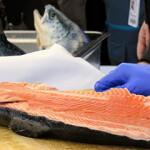New satellite tools reveal evasive tactics of Chinese squid fleet

Increasingly sophisticated satellite systems are making life much harder for vessels perpetrating illegal fishing, according to Starboard Maritime Intelligence, a New Zealand-based satellite firm.
Starboard recently contributed to a Uruguayan investigation of a Chinese vessel, the Lu Rong Yuan Yu 606, detained for allegedly squid jigging in Uruguay’s exclusive economic zone.
Starboard has come up with a system of tracking and displaying “missing AIS [automatic identification system] events” and “loitering and missing AIS events,” which are then viewable in playback mode on the Starboard platform. This makes analysis of vessel movements “more intuitive and efficient,” according to Starboard.
The Starboard platform allows real-time tracking of vessels through mapping of AIS data, with another function allowing for retracing of the movements of a vessel over various periods of time, according to Sabina Goldaracena, a Uruguay-based journalist specializing in fishing activity in the Southwest Atlantic Ocean.
According to Goldaracena, there is a particular problem with tracking Chinese vessels, which she blames on either “poor-quality equipment or intentional spoofing.”
“You have flying ships that cross continents at 100 miles per hour or vessels in two places at the same time,” she told SeafoodSource. “How were they in the middle of Antarctica two days ago and now they are in Montevideo? The Chinese fleet is the most-confusing fleet. Everything is not coherent.”
Starboard analysis shows extensive periods of missing AIS tracking for the Lu Rong Yuan Yu 606 during its time fishing in the high seas of the Southwest Atlantic. The vessel was reporting its movements on an hourly basis via vessel-monitoring system (VMS) required by China, and submitting its detailed position data to Uruguay twice daily. But the Lu Rong Yuan Yu 606 was intercepted after a flyover by a Uruguyan military jet showing the vessel fishing at night in the country’s territorial waters.
Goldaracena said the Starboard system allowed her to disprove the claims of the vessel’s captain that the intercepting warship was not identifiable because it had switched off its AIS. Starboard tracking data showed the naval vessel had its AIS switched on throughout the interception and chase, according to Goldaracena. Goldaracena detailed her investigation into the incident in an article posted on Starboard’s website.
The Lu Rong Yuan Yu 606’s sister vessels have also attracted international attention. The Lu Rong Yuan Yu 956 was detained in Ghana in 2020 and accused of illegal fishing. And the Lu Rong Yuan Yu 267 and 268 were featured in 2020 in a government-financed film titled “Hai Yang Dui Yu Ji,” directed by noted filmmaker Jing Jian Min, which cast the vessels in a positive light, with the narrator describing a “magnificent voyage” by the vessels from Sha Wo Dao port near the city of Rongcheng to fish in the Indian Ocean.
In response to numerous fishing disputes in the Southwest Atlantic, there has been a growing call from environmental nonprofits and national governments for a new regional fishery management organization (RFMO) covering that area of the high seas.
Photo courtesy of Uruguay Public Prosecutor's Office/Sabina Goldaracena/Starboard






Share